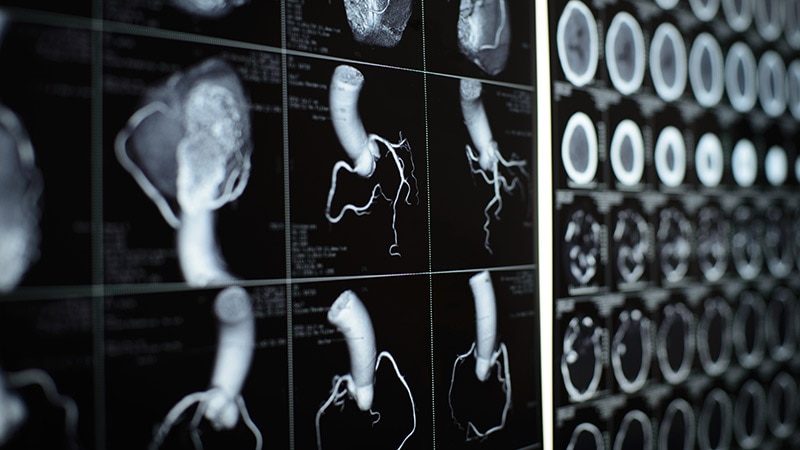AI Interpretation of CCTA: Inflammation Predicts CV Events
Core Concepts
Arterial inflammation measured by AI in CCTA predicts cardiovascular events in nonobstructive CAD patients.
Abstract
The study discusses how AI can predict fatal and nonfatal events in patients with nonobstructive coronary artery disease (CAD) by measuring arterial inflammation through coronary computed tomography angiography (CCTA). The analysis is based on the Fat Attenuation Index (FAI) and aims to change treatment approaches. Key insights include:
- AI-assisted CCTA can predict cardiac events independently of clinical risk scores.
- The FAI score quantifies residual risk in nonobstructive CAD patients.
- An AI risk model combining FAI and risk factors is generalizable and reclassifies patients effectively.
- FAI scores show significant predictive value for major adverse cardiovascular events (MACE) and cardiac mortality.
- AI-based risk assessment can lead to changes in patient management.
- The potential of AI-enhanced FAI interpretation in managing nonobstructive CAD patients.
- Recommendations for further studies to validate AI's contribution to risk stratification.
Customize Summary
Rewrite with AI
Generate Citations
Translate Source
To Another Language
Generate MindMap
from source content
Visit Source
www.medscape.com
AI Interpretation of CCTA: Inflammation as CV Risk Factor
Stats
"In absolute terms, the nonobstructive CAD group had about twice as many MACE (2,587 vs. 1,450) and cardiac deaths (1,118 vs. 636)."
"Those in the highest FAI quartile had a hazard ratio (HR) for MACE that was more than six times higher (HR 6.76; P < .001) and a risk of cardiac mortality that was more than 20 times higher (HR 20.20; P < .001) than that of those in the first quartile."
"When evaluated in nonobstructive disease, the predictive value of FAI was even greater."
Quotes
"AI-risk assessment may transform risk stratification and management of patients undergoing routine CCTA." - Dr. Antoniades
"This is an incredibly intriguing idea that deserves continuing research." - Dr. Taqueti
Key Insights Distilled From
by Ted Bosworth at www.medscape.com 11-27-2023
http://www.medscape.com/viewarticle/998817
Deeper Inquiries
How can AI integration in healthcare be optimized beyond cardiovascular risk prediction?
AI integration in healthcare can be optimized beyond cardiovascular risk prediction by expanding its applications to various areas such as personalized treatment plans, drug discovery, early disease detection, and patient monitoring. By leveraging AI algorithms to analyze vast amounts of patient data, healthcare providers can tailor treatments to individual patients, leading to more effective and efficient care. Additionally, AI can assist in identifying new drug targets and predicting patient responses to medications, ultimately improving treatment outcomes. Furthermore, AI can aid in the early detection of diseases through advanced imaging techniques and biomarker analysis, enabling timely interventions and better prognosis. Continuous patient monitoring using AI-powered devices can also enhance preventive care and management of chronic conditions.
What are the potential limitations or biases in relying on AI for patient risk assessment?
While AI offers significant benefits in patient risk assessment, there are potential limitations and biases that need to be addressed. One limitation is the lack of transparency in AI algorithms, making it challenging to understand how decisions are made. This opacity can lead to mistrust among healthcare providers and patients. Biases in AI algorithms, stemming from biased training data or algorithm design, can result in disparities in patient risk assessments, particularly for underrepresented populations. Additionally, overreliance on AI without human oversight can lead to errors or misinterpretations of data, potentially compromising patient care. It is crucial to continuously monitor and evaluate AI systems to mitigate these limitations and biases in patient risk assessment.
How can advancements in AI for medical imaging impact healthcare accessibility and affordability?
Advancements in AI for medical imaging have the potential to significantly impact healthcare accessibility and affordability by improving diagnostic accuracy, reducing wait times, and optimizing resource allocation. AI-powered imaging technologies can enhance the efficiency and accuracy of diagnostic processes, leading to earlier detection of diseases and more precise treatment planning. This can result in reduced healthcare costs associated with misdiagnoses or delayed treatments. Moreover, AI can help streamline imaging workflows, allowing healthcare providers to see more patients in a shorter amount of time, thus increasing accessibility to imaging services. By automating repetitive tasks and enhancing diagnostic capabilities, AI can also alleviate the burden on healthcare professionals, potentially addressing workforce shortages and improving overall healthcare quality and efficiency.
0
